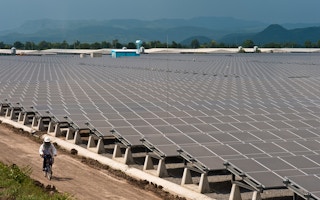As Cambodia assumes the chairmanship of the Association of Southeast Asian Nations (Asean) this year, its government is calling for more international support for emerging economies in the region, as these countries revamp their energy systems to fulfill Asean’s pledge of transitioning to clean renewables.
To continue reading, subscribe to Eco‑Business.
There's something for everyone. We offer a range of subscription plans.
- Access our stories and receive our Insights Weekly newsletter with the free EB Member plan.
- Unlock unlimited access to our content and archive with EB Circle.
- Publish your content with EB Premium.
At a summit organised by the EU-Asean Business Council, Cambodia’s deputy prime minister and minister for finance and economy Aun Pornmoniroth highlighted “overwhelming financing needs” in the region’s low income and developing economies. Emerging markets in Asean are facing problems brought about by limited fiscal resources, after deploying substantial stimulus and expansionary policy measures in their fight against Covid-19, he said.
“The pandemic has set back Asean’s hard-earned progress in its advance towards the Sustainable Development Goals (SDGs). There is a massive green financing shortfall for developing economies right now, and investing in sustainable and resilience development might not be feasible for them without close cooperation and support from developed countries,” said Pornmoniroth in his keynote address.
Pornmoniroth was speaking after the 8th Asean Finance Ministers’ and Central Bank Governors’ Meeting, held virtually this month, and heavily focused on sustainable financing. At the regional meet, the kingdom of Cambodia had given special prominence to the need to leverage sustainable green technologies and practices to enhance the resilience of Asean economies.
‘Wall of money’ available to fuel green transition: Alok Sharma
According to data compiled by the ISEAS-Yusof Ishak institute, which runs a programme on climate change in Southeast Asia, from 2000 to 2019, developed countries mobilised a total of US$533 billion in climate finance for developing countries and Asean countries (except Brunei and Singapore) received a total of US$56 billion of that financing, making up 10.56 per cent of the total assistance.
On average, developed countries provided only US$86 per person in eight Asean countries over 20 years, or as little as US$4 per person annually, the data shows.
A large proportion of bilateral climate finance also comes from within the region itself, with the Japanese government — which provided 65 per cent of total bilateral climate finance between 2000 to 2019 — being the biggest donor. Its contribution outstrips that of Germany and France, which is at 11.8 per cent and 8.4 per cent respectively.
“
Aspirationally, we need to ask ourselves: can Asean have a Green Deal like Europe? It might be difficult, and some might say it is impossible, but we ought to start somewhere.
Ramesh Subramaniam, Director-General, Southeast Asia department, ADB Asian Development Bank
In February this year, COP26 president Alok Sharma, on his visit to Indonesia and Vietnam, emphasised that Southeast Asia needs climate cash to push for reforms that will fuel its green transition.
The British official, who helmed last year’s climate talks in Glasgow, said that there is a “wall of money” available for Asia to help low-income and developing economies invest in renewable energy, cleaner transport and industry, but these countries need to enact reforms of their energy systems and pledge more ambitious climate targets under the 2015 Paris Agreement, the world’s main climate pact.
Sharma will be helping to coordinate climate diplomacy with Egypt ahead of November’s COP27 climate conference in Sharm El-Sheikh. Observers expect more pressure to be exerted on rich nations to help developing countries decarbonise as the summit approaches.
Ramesh Subramaniam, who heads the Southeast Asia department at Asian Development Bank (ADB), said that the current shortfall in green financing for Asean is enormous. The region requires a total US$210 billion in infrastructure investment until 2030; for renewable energy alone, Asean needs about US$27-28 billion a year.
“But we are getting only about one-tenth of that right now, so clearly the unmet needs are huge,” he said.
Unlocking ‘unbankable projects’
One critical problem is the lack of bankable projects in the region, said Subramaniam. In September last year, with the support of ADB, Singapore sovereign wealth fund Temasek and HSBC bank announced a partnership to establish a debt financing platform dedicated to sustainable infrastructure projects with an initial focus on Southeast Asia, as part of efforts to reduce climate change. Subramaniam said the initiative is one way to “make unbankable projects bankable” — blended finance will be deployed at scale to unlock marginally bankable projects, and crowd in more private and institutional investors.
“The key focus is to go into amber and red projects, which have stalled in their progress, and which the private sector will not go into, and turn them green,” he said.
Subramaniam believes that with the renewed global focus and attention on green recovery and the aspiration to build back better, there is now an opportunity for Asean to work with other countries.
“Aspirationally, we need to ask ourselves: can Asean have a Green Deal like Europe? It might be difficult, and some might say it is impossible, but we ought to start somewhere,” he said, referring to a set of policy initiatives by the European Commission announced in 2020, with the overarching aim of making the European Union climate neutral by 2050.
Pornmoniroth, who co-chaired the recent regional meet of finance ministers with Cambodia’s national bank governor Chea Chanto, said that the government of Cambodia recognises that increasing vulnerabilities of climate change as well as natural disasters can drastically undermine national progress in achieving inclusive and sustainable development in Asean, especially in the emerging economies, where financing availability is limited.
Cambodia, as Asean chair, is committed to helping Asean mobilise green investments to help bridge the financing gap, said Pornmoniroth. “It is crucial, regardless of development stage, for each country to now address their sustainable challenges by channelling investment flows to support the energy transition.”








